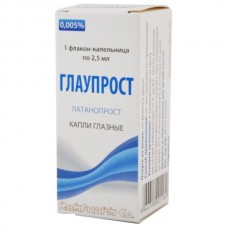Expiration date: 03/2026
Release form, composition and packaging
Eye drops 0.005% transparent, colorless.
Excipients: disodium hydrogen phosphate dodecahydrate, sodium dihydrogen phosphate dihydrate, sodium chloride, benzalkonium chloride, purified water.2.5 ml dropper bottle polymer (1) - packs of cardboard.Clinico-pharmacological group: drug Protivoglaucomny
Registration ??:
eye drops 0.005%: FL.-kapelln. 2.5 ml of 1 - PL-000006, 19.10.10
1 ml contains:
latanoprost 50 micrograms
Pharmacological action
Anti-glaucoma drug. Is an analogue of prostaglandin F2 and a selective agonist of the FP receptor.
Reduces intraocular pressure by increasing the outflow of aqueous humor, mainly via uveoscleral route, and also through the trabecular meshwork. No significant effect on products watery moisture and does not affect gematoentsefalichesky barrier.
Reduction of intraocular pressure begins 3-4 hours after drug administration, the maximum effect observed after 8-12 h, the effect of prodoljaetsa for at least 24 hours
Pharmacokinetics
Absorption and distribution
Penetrates well into the cornea, with hydrolysis to the biologically active form. The time to reach Cmax in watery moisture 2 h after topical application.
Metabolism and excretion
The eye tissues latanoprost acid is practically not metabolized, metabolism occurs mainly in the liver.
T1/2 is 17 min. Major metabolites, 1,2-dinor - and 1,2,3,4-tetranor-metabolites have no or weak biological activity. Excreted by the kidneys.
Indications for use of the drug Glauprost
— open angle glaucoma,
— increased intraocular pressure.
The dosage regimen
In conjunctival the affected eye instilled 1 drop 1 time/ evening, skip the next dose is administered in normal mode (i.e. dose double).
Side effects
On the part of the organ of vision: eye irritation (burning sensation, feeling of sand in eyes, itching, stinging and foreign body sensation), blepharitis, conjunctival hyperemia, eye pain, increased pigmentation of the iris, transient point of erosion of epithelium, swelling of the eyelids, swelling and corneal erosion, conjunctivitis, lengthening, thickening, increased numbers and increased pigmentation of eyelashes and downy hair, iritis/uveitis, keratitis, macular edema (including custody), changing the direction of eyelash growth, sometimes causes eye irritation, blurred vision.
Dermatological reactions: rash, darkening of the eyelid skin and local skin reactions on the part of the eyelids.
From the nervous system: dizziness, headache.
The respiratory system: bronchial asthma (including acute attacks or exacerbation of the disease in patients with bronchial asthma in history), shortness of breath.
From the side of musculoskeletal system: muscle pain, joint pain.
Other: nonspecific chest pain.
Contraindications to the use of the drug Glauprost
— the age 18 years,
— hypersensitivity to the drug.
With caution should use the drug in patients with aphakia, pseudophakia with rupture of the posterior lens capsule, patients with known risk factors for macular edema (when treating latanoprost described cases of macular edema, including cystoidea), patients with inflammatory, neovascular or congenital glaucoma (due to the lack of sufficient experience with the drug).
The use of the drug Glauprost during pregnancy and breastfeeding
Application Glauprost when pregnancy is possible only under the supervision of a physician and only if the expected benefit to the mother outweighs the risk of possible side effects in the fetus.
Latanoprost and its metabolites can be transferred with breast milk. If necessary, the appointment Glauprost during lactation, breastfeeding should be discontinued.
Special instructions
The use of the drug Glauprost causes a gradual change in eye color by increasing the amount brown pigment in the iris. This effect is revealed mainly in patients with mixed colour irides, such as blue-brown, gray-brown, green-brown or yellow-brown, which is due to increased melanin content in stromal melanocytes of the iris. Usually brown pigmentation extends concentrically around the pupil to the periphery of the iris of the eye, the entire iris or parts of it could become more intense brown color. In case of intensive changes in the pigmentation of the eye therapy is stopped.
In patients with a uniformly colored eyes of blue, gray, green or brown color change of eyes after 2 years of using the drug are observed very rarely. Developed the color change may be irreversible. Before starting treatment patients should be informed about the possibility of changing eye color.
In patients, applying drops only in one eye may develop heterochromia.
Latanoprost may cause a gradual change in eyelashes and vellus hair, such as lengthening, thickening, increased pigmentation, increased thickness and changing the direction of eyelash growth. Eyelash changes are reversible and disappear after cessation of treatment.
The product contains benzalkonium chloride which may be adsorbed by contact lenses. Before the instillation of eye drops contact lenses should be removed, to insert lenses only after 15 minutes after instillation.
Prescribing combination therapy eye drops of various medicines should be administered at intervals of not less than 5 min.
Effects on ability to drive vehicles and management mechanisms
The patients that after applying eye drops observed transient blurred vision, avoid driving vehicles or work with mechanisms to recover it.
Overdose
Symptoms: irritation of eyes, redness of the conjunctiva or episclera.
Treatment: symptomatic therapy.
Drug interactions
The simultaneous instillation of two analogues of prostaglandins can cause a paradoxical increase in intraocular pressure.
Farmatsevticeski incompatible with eye drops containing thiomersal, is precipitation.
Conditions of supply of pharmacies
A drug dispensed by prescription.
Terms and conditions storage
The drug should be stored out of the reach of children, protected from light place at temperature from 2° to 8°C. shelf Life - 3 years. After opening the bottle the drug should be stored at temperatures not above 25°C and use within 4 weeks.



